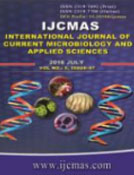


 National Academy of Agricultural Sciences (NAAS)
National Academy of Agricultural Sciences (NAAS)

|
PRINT ISSN : 2319-7692
Online ISSN : 2319-7706 Issues : 12 per year Publisher : Excellent Publishers Email : editorijcmas@gmail.com / submit@ijcmas.com Editor-in-chief: Dr.M.Prakash Index Copernicus ICV 2018: 95.39 NAAS RATING 2020: 5.38 |
Corneal infection is leading cause of ocular morbidity and blindness worldwide. Identification of the pathogen, initiation of immediate therapy based on the organism identified represent the keys to success in management of corneal ulcers. Aim of this study is to define the bacteriological profile of corneal ulcers and to test their in-vitro bacterial susceptibility. Patients presenting with suspected bacterial corneal ulceration 2015 were included. Corneal scraping was performed and processed for direct microscopy, and bacteriological culture. Antimicrobial susceptibility testing was done according to CLSI guidelines. Of 300 specimens examined, 62(20.7%) had bacterial growth. Gram positive cocci were comprised of 43(69.4%) and gram negative bacilli 19(30.6%). The commonest bacterial pathogen isolated was Staphylococcal aureus 28(45.2%), followed by Coagulase Negative Staphylococci 8 (12.9%) and Streptococcus 7(11.21%). Pseudomonas spp 5 (8.1%) and E.coli 5 (8.1%). Staphylococcus aureus and E.coli were 100% susceptible and all other strains were >80% susceptible to gentamycin and amikacin. Staphylococcus spp. were the most common bacterial pathogens isolated from patients with corneal ulcers in this institute. High percentages of gram-positive and gram-negative bacteria were susceptible to aminoglycosides. So, these drugs appear to be the therapy of choice for corneal ulcers. Routine microbiological examination of corneal ulcer is necessary to analyze the microbial etiology and to treat them with appropriate antibiotics to prevent further complications.
 |
 |
 |
 |
 |